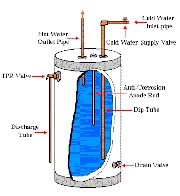Smelly Water From Water Heaters
There are many misconceptions in today's marketplace regarding the development and treatment of smelly water in the water heater. The most common odor complaint, "rotten egg smell" is derived from hydrogen sulfide gas dissolved in the water. Concentrations as little as one PPM can result in this odor. The smell is the result of six factors that must be present for the odor to develop in the water heater.
- There is a high concentration of sulfate in the water.
- There is little or no dissolved oxygen in the water
- There is a sulfate-reducing bacteria within the water heater. This bacteria is non-toxic to humans.
- There is an excess of active hydrogen in the tank. The cathodic action of the anode can produce hydrogen gas.
- Old galvanized pipes can add to the iron concentration in the water heater.
- Galvanized and copper pipe should be separated by a Teflon disc union to remedy the electrolysis on the pipes.

These products of hydrogen and sulfur will combine to form hydrogen sulfide gas or "rotten egg smell" in the water. Active use of the water heater will reduce the problem, but idle water heaters, such as those in summer homes, will allow the accumulation of this hydrogen sulfide gas and add to the odor problem.
Smelly water can most easily be reduced or eliminated by replacing the magnesium anode on the water heater with one of a less active material such as aluminum, and by flushing the tank every six months.
CAUTION: Do not permanently remove the anode, as this will leave the tank unprotected. Always turn off all electric power and gas to the water heater before draining.
Pink Stains in Bathroom Fixtures
Pink residue is less likely a problem associated with water quality than with naturally occuring airborne bacteria, and is also affected by cleaning habits. The bacteria produces a pinkish film, and sometimes a gray film, on surfaces that are regularly moist, including toilet bowls, shower heads, sinks and tiles.
To determine the exact species of bacteria would require lengthy and costly laboratory testing, and homeowners are reluctant to have the tests performed. Although the exact species of bacteria is not known, most experts have concluded that this pink staining is most likely from the bacteria Serratia marcescens. These bacteria thrive on moisture, dust and phosphates and are widely distributed, having been found in soil, food and animals. The conditions for the survival of Serratia marcescens are minimal and the bacteria may feed upon itself in the absence of other nutrients.
Members of the Serratia genus were once known as harmless organisms that produced a characteristic red pigment. Because of this, scientists and teachers frequently used it in experiments to track other microbes. More recently, Serratia marcescens has been found to be pathogenic to some people, having been identified as a cause of urinary tract infections, wound infections and pneumonia, and it is no longer recommended for use in school experiments.
Once airborne, the bacteria seek moist environments to proliferate. Some people have noticed the pink residue in their pet's water bowl. This causes no apparent harm and can easily be cleaned. Others have indicated that their experience with this nuisance occurs during a time of year when their windows are open for the majority of the day. These airborne bacteria can come from any number of naturally occuring sources, and the condition can be further aggravated if customers remove the chlorine from their water by way of an activated carbon filter.
The best solution to keep surfaces free from the baterial film is continual cleaning. A chlorinated compound is best, such as a household cleaner with bleach. Use care with abrasives to avoid scratching the fixtures, which will make them even more susceptible to bacteria. Chlorine bleach can be periodically stirred into the toilet tank and flushed into the bowl. As the tank refills, more bleach can be added. Three to five tablespoons of fresh bleach should be sufficient. A toilet cake that contains a disinfectant can keep a residual in the water at all times. Cleaning and flushing with chlorine will not necessarily eliminate the problem, but will help to control the bacteria. Keep bathtubs, showers and sinks wiped down and dry to avoid the problem.
While all water utilities are concerned about the quality of the product they are supplying to customers, they cannot guarantee water quality once it leaves the pressurized distribution system and enters the customer's plumbing.
